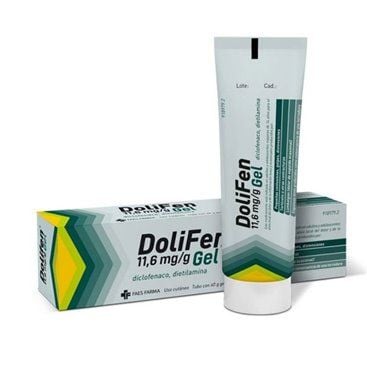Dolifen 11,6 Mg/G Skin Gel 60 G
Diclofenac diethylamine, the active ingredient in this medicine, belongs to the group of non-steroidal anti-inflammatory drugs and acts as a local analgesic and anti-inflammatory. This medicine is indicated in adults and adolescents over 14 years of age.
Diclofenac diethylamine, the active ingredient in this medicine, belongs to the group of non-steroidal anti-inflammatory drugs and acts as a local analgesic and anti-inflammatory. This medicine is indicated in adults and adolescents over 14 years of age.
Dolifen (11.6 Mg / G Skin Gel 1 Tube 60 G)
ACTION AND MECHANISM
- Anti-inflammatory and topical analgesic. Diclofenac is a non-steroidal anti-inflammatory derived from phenylacetic acid, which acts by preventing the synthesis of prostaglandins and other prostanoids, by inhibiting cyclooxygenase that intervenes in inflammatory processes.
PHARMACOKINETICS
- Absorption:
* Topical gel: Bioavailability of 6%. The Cmax is 15-53.8 ng / ml, reaching 10-14 h after application.
- Distribution: High binding to plasma proteins (99%), mainly albumin. Vd of 1.3 l / kg.
- Metabolism: It is almost completely metabolized in the liver, through hydroxylation reactions and glucuronic conjugation.
- Elimination: It is eliminated in urine (65%) and bile (35%), mainly as conjugated metabolites. Small amounts of unchanged diclofenac are detected in urine and bile. The t1 / 2 is 2 h.
INDICATIONS
- Symptomatic treatment of processes that occur with [INFLAMATION] and / or [ACUTE PAIN], such as:
* [CONTUSION] or [SPRAIN] produced by sprains.
* [TORTICOLIS] or other [MUSCULAR CONTRACTURE].
* [LUMBALGIA].
* Acute or post-traumatic musculoskeletal processes, such as [TENDINITIS], [TENOSINOVITIS], [ARTHRITIS].
- [ARTHROSIS].
POSOLOGY
"DOLOTREN"
-Adults and children from 6 years: apply a thin layer (2-4 g of gel, equivalent to 5-10 cm), 3-4 times a day.
RULES FOR CORRECT ADMINISTRATION
It should be applied to healthy and intact skin, without injuries or open wounds. Covering the area with occlusive bandages is not recommended. Its application near the eyes, as well as on mucous membranes, should be avoided. After application, hands should be washed unless they are the site of treatment.
- Topical gel: It will be applied on the area to be treated, massaging until the gel is absorbed. Wash your hands next.
CONTRAINDICATIONS
- Hypersensitivity to diclofenac or any other component of the drug. There are reports of cross allergic reactions between different NSAIDs, as well as with salicylates, so it is not recommended to use diclofenac in the case of [NSAID ALLERGY] or [SALICYLATE ALLERGY].
- In patients who have previously suffered attacks of [ASTHMA], [URTICARIA] or [RHINITIS] caused by acetylsalicylic acid or another non-steroidal anti-inflammatory drug (NSAID).
- Do not apply on wounds, eczematous lesions, mucous membranes, or burns.
- In children and adolescents under 14 years of age.
- In the third trimester of pregnancy.
- Do not administer concomitantly with other products containing diclofenac
PRECAUTIONS
- [PHOTOSENSITIVITY REACTIONS]. Diclofenac has caused photosensitivity reactions. It is recommended not to expose the treated areas to the sun or UV light for at least one day.
- Systemic reactions. The risk of systemic reactions from topical diclofenac is minimal, although it cannot be ruled out if there is significant systemic absorption, as can happen if applied to damaged skin areas (dermatitis, burns, wounds) or with an occlusive bandage. . It is recommended to adhere to the dosage recommendations in patients with asthma, a history of peptic ulcer, kidney or heart failure, as well as hypertension.
ADVICE TO THE PATIENT
- The doctor and / or pharmacist should be consulted if previous allergic reactions to other anti-inflammatories, including acetylsalicylic acid, have been described.
- Do not cover the area with occlusive bandages.
- It should not be applied to areas of skin with burns, open wounds, dermatitis or infections.
- Do not expose the treated areas to the sun or UVA light sources until at least one day after the last application.
- Consult with the doctor and / or pharmacist if the symptoms continue or worsen after the days established in the package leaflet for the corresponding presentation.
- Apply to the skin by massaging until the gel is absorbed.
INTERACTIONS
No interactions have been described at the recommended doses. However, in case of significant systemic absorption, the same interactions could occur as with systemic diclofenac.
In addition, and as with any topical treatment, it is not advisable to administer two topical medications at the same time on the same area.
PREGNANCY
Safety in animals: the prenatal, perinatal and postnatal development of the progeny was not affected.
Safety in humans: approximately 10% of the topical dose is absorbed systemically with considerably less bioavailability topically than orally. There are no adequate and well-controlled human studies with topical diclofenac, but systemic diclofenac has resulted in fetal toxicities in late pregnancy. Although skin absorption is minimal, it cannot be ruled out that systemic effects do not appear.
The topical use of diclofenac during the first two trimesters of pregnancy is only accepted if, in the absence of other safer therapeutic alternatives, the benefits outweigh the possible risks.
The use of diclofenac during the third trimester of pregnancy is contraindicated, since diclofenac has been associated with delayed delivery, and adverse cardiopulmonary effects in the fetus, such as premature closure of the ductus arteriosus and pulmonary hypertension, and kidney, such as acute renal failure and oligohydramnios. It can also increase the bleeding time in the mother.
Effects on fertility: There is no evidence that diclofenac has a teratogenic potential in mice, rats, or rabbits. In humans, preclinical data obtained in acute toxicity and repeat dose studies, as well as genotoxicity, mutagenesis and carcinogenicity studies with diclofenac have revealed that there is no specific risk at the anticipated therapeutic doses.
LACTATION
It is not known whether diclofenac topical is excreted in milk, and the consequences for the nursing infant. Approximately 10% of the topically applied dose is absorbed systemically. Systemic diclofenac is excreted in small amounts in human milk. Manufacturers advise stopping breastfeeding or avoiding its administration.
KIDS
See the posology section in which it is specified from what age it can be used in children.
SENIORS
The elderly can be especially susceptible to the adverse reactions of diclofenac, so use with caution is recommended.
ADVERSE REACTIONS
- Dermatological: Frequent (1-10%) local reactions in the application area, such as [PRURITO], [SKIN IRRITATION], [ERYTHEMA], [EXANTEMATIC ERUPTIONS], with the appearance of pustules or papules on occasions.
- Allergic: Uncommon (0.1-1.0%) [HYPERSENSITIVITY REACTIONS], [CONTACT DERMATITIS]; specific cases of [ANAPHYLAXIA], [ANGIOEDEMA] and [PHOTOSENSITIVITY REACTIONS].
In case of significant absorption, the systemic adverse reactions of diclofenac could appear.
ADVERSE REACTIONS RELATING TO EXCIPIENTS
- This medicine contains propylene glycol, so it can cause [SKIN IRRITATION].
OVERDOSE
Symptoms: Due to its route of administration, symptoms are unlikely to appear in the event of an overdose, although accidental ingestion or improper application could produce typical systemic adverse effects.
Treatment: In case of accidental ingestion, stomach lavage and symptomatic treatment will be carried out.



